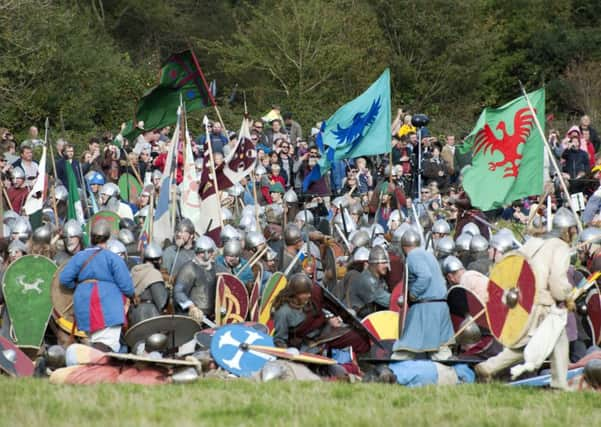Battle of Hastings brought to life once more
This article contains affiliate links. We may earn a small commission on items purchased through this article, but that does not affect our editorial judgement.


English Heritage organised the dramatic event, on the battlefield behind the Abbey, to mark the centenary of the Battle of Hastings.
As well as the dramatic clashes, onlookers were able to get a taste of the domestic life of the period with a number of authentic crafts of the time being demonstrated. They were also able to get a feel for what it would have been like to be a camp follower at the time.
Advertisement
Hide AdAdvertisement
Hide AdMore than 500 soldiers and horsemen were involved in the battle reenactment, which took place on Saturday and Sunday.
Fine weather attracted hundreds of onlookers who enjoyed the spectacle.
Harold’s resting place:
The battle saw the defeat of King Harold and the Saxons and turned the tide of history, but where is he buried?
Historian David Dennis explores the mystery.
He writes: A Saxon giant has been unearthed at Bosham, a Saxon port in Hampshire and the skeleton shows great mutilation to match the battle descriptions – but Harold’s father and murdered brother also were buried here.
Advertisement
Hide AdAdvertisement
Hide AdYet if the battle really was at Hastings either at Senlac Hill south of Battle or north at Caldbec Hill as many say, then Bulverhythe harbour and Glyne Gap’s Galley Hill cliffs were the nearest foreshores out of the Combe Valley estuary – and the re-siting of the Edith Swan-Neck statute to Gensing Gardens is surely an echo of that.
In the last one thousand years the coast has been massively altered - and rather than erosion it has been longshore drift deposition that has changed it.
The factual position about the Battle of Hastings is deeply unsatisfactory.
A cloud of unknowing exists. No excavation, ‘geophys’ or LIDAR ground examination has revealed anything that would help us to know the absolute truth of these events so that we do not have to repeat the jingoistic status quo.
Advertisement
Hide AdAdvertisement
Hide AdSo some historians are looking again at ancient manuscripts and one of these tells the tale that Harold escaped alive! I also understand from private communication that English Heritage are so beset with queries about the true history of 1066 that they may
bring in a new archeology team to re-examine the area around Battle.
In Geoffrey Hindley’s book, The Anglo Saxons – The Beginning of the English Nation, he reveals that a scribe called Saebeorht writing at Waltham Abbey states in the document ‘Vita Haroldi’ that in fact Harold was taken from the battlefield at Hastings more dead than alive and was hidden for two years at Winchester, cared for by an Arab Saracen woman who knew of middle eastern medicine. Once made whole again he travelled to German to try and whip up support for an invading army, but being unsuccessful he took a boat and found a cave near Dover where he lived in hiding, wearing a chain mail shirt next to his skin as penance.
He then fled to Wales, was rebutted and ended his days as a face-veiled hermit in Chester.
Advertisement
Hide AdAdvertisement
Hide AdJust before he died he told those gathering near him. “I am Harold Godwinesson, your true king.” This ancient document, the Vita Haroldi is held by the British Museum and is generally uncontested but is considered to be a ‘romance’.
However, the anchorite chapel where Harold may have lived in hiding as a veiled monk at St John’s, Chester still exists and it was visited by Henry the First who confirmed he had met with a monk called Harold.
There are also documents saying that later a ‘kingly corpse’ was found there, with a crown and sword.
Don’t miss out on all the latest breaking news where you live.
Advertisement
Hide AdAdvertisement
Hide AdHere are four ways you can be sure you’ll be amongst the first to know what’s going on.
1 Make our website your homepage at www.hastingsobserver.co.uk
2 Like our Facebook page at www.facebook.com/hastingsobserver
3 Follow us on Twitter @HastingsObs
4 Register with us by clicking on ‘sign in’ (top right corner). You can then receive our daily newsletter AND add your point of view to stories that you read here.
And do share with your family and friends - so they don’t miss out!
The Hastings Observer - always the first with your local news.
Be part of it.